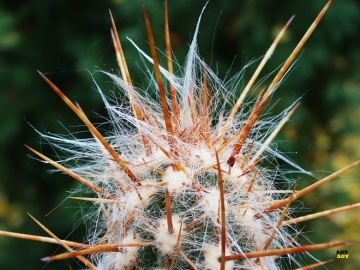= Oreocereus hendriksenianus Backeb. in Backeb. & F.M.Knuth
Kaktus-ABC [Backeb. & Knuth] 186, 411. 1936 [12 Feb 1936] Backeb., F.M.Knuth
Accepted Scientific Name: Oreocereus leucotrichus (Phil.) Wagenkn.
Anales Acad. Chilena Ci. Nat. no. 20: 102. 1956

Borzicactus hendriksenianus (Oreocereus hendriksenianus) Photo by: Agócs György
Origin and Habitat: Southern Peru, Northern Chile.
Synonyms:
See all synonyms of Oreocereus leucotrichus
back
Accepted name in llifle Database:Oreocereus leucotrichus (Phil.) Wagenkn.Anales Acad. Chilena Ci. Nat. no. 20: 102. 1956Synonymy: 12
back
Common Names include:
ENGLISH: Old Man of the Andes.
SPANISH (Español): Chastudo, Cactus blanco, Cardόn blanco, Chastudo peludo, Chica-chica, Pichaja, Quisco, Tunilla, Viejito, Abuelo
Description: Oreocereus hendricksenianus is a clustered columnar cactus that form groups up to 1.4 m tall and 2 m in width. At first the body is club shaped, becoming cylyndrical with age, though growth is slow. The beauty of this plant lies in the covering of silky white, yellowish, red-brown to black hair, completely concealing the stem, protruding through which are stout, brightly coloured spines. Oreocereus hendricksenianus is very similar in appearance to Oreocereus ritteriSN|17844]]SN|17844]], with the added attraction of more hair colours. The chocolate-coloured form is most unusual, and it comes in yellow and white as well. Usually chocolate-coloured form produce hair of chocolate colour only on new growth, but soon bleaching.
Remarks: Oreocereus hendriksenianus, nowadays is considered by most authors to be a variety of Oreocereus leucotrichus, thought some other authors still considered it a different species.
Stem: Columnar, erect, branching from base,1(-1.4) m tall, almost 10 cm thick, green.
Ribs: Ribs 10, with a transverse furrow, which is completely obscured by the mass of hairs between the areoles.
Radial spines: 8-9 (-10) fine no more than 1 cm in length.
Central spines: (1-)4 stronger, up to 5 cm in length, sharp, standing out from the stem in a very aggressive manner, yellowish, orangish, horn-coloured or dark brown
Flowers: Pink to carmine red, around 7 cm long, tubular, zygomorphic and densely hairy.
Flowering Time: Summer.
Subspecies, varieties, forms and cultivars of plants belonging to the Oreocereus leucotrichus group
 Oreocereus hendriksenianus Backeb. in Backeb. & F.M.Knuth: has about 10 ribs, the silky hair is white, but also yellowish, red-brown or even black, protruding through which are stout, brightly coloured spines. Distribution: Southern Peru, Northern Chile.
Oreocereus hendriksenianus Backeb. in Backeb. & F.M.Knuth: has about 10 ribs, the silky hair is white, but also yellowish, red-brown or even black, protruding through which are stout, brightly coloured spines. Distribution: Southern Peru, Northern Chile. Oreocereus leucotrichus (Phil.) Wagenkn.: Has 10-15 (or more) ribs covered with with abundant white to black silky hairs 5-10 cm long, thicker on the more recent vegetation. Distribution: Southern Peru, Northern Chile.
Oreocereus leucotrichus (Phil.) Wagenkn.: Has 10-15 (or more) ribs covered with with abundant white to black silky hairs 5-10 cm long, thicker on the more recent vegetation. Distribution: Southern Peru, Northern Chile.
Bibliography: Major references and further lectures
1) Edward Anderson “The Cactus family” Timber Press, Incorporated, 2001
2) James Cullen, Sabina G. Knees, H. Suzanne Cubey "The European Garden Flora Flowering Plants: A Manual for the Identification of Plants Cultivated in Europe, Both Out-of-Doors and Under Glass" Cambridge University Press, 11/Aug/2011
3) David R Hunt; Nigel P Taylor; Graham Charles; International Cactaceae Systematics Group. "The New Cactus Lexicon" dh books, 2006
4) Bill Keen “Cacti and Succulents: Step-by-Step to Growing Success” Crowood, 18 Oct 2011
5) Brian Lamb “Letts guide to cacti of the world” Letts, 17 Oct 1991
6) Willy Cullmann, Erich Götz (Dozent Dr.), Gerhard Gröner “The encyclopedia of cacti” Timber Press, 1987
7) The National Cactus and Succulent Journal: The Official Journal of the National Cactus & Succulent Society, Volumes 31-34 page 99 National Cactus and Succulent Society, 1976
 Borzicactus hendriksenianus (Oreocereus hendriksenianus) Photo by: Agócs György
Borzicactus hendriksenianus (Oreocereus hendriksenianus) Photo by: Agócs GyörgySend a photo of this plant.The gallery now contains thousands of pictures, however it is possible to do even more. We are, of course, seeking photos of species not yet shown in the gallery but not only that, we are also looking for better pictures than those already present.
Read More... Cultivation and Propagation: This is a a much decorative frost hardy cactus that grow at high altitude and is suitable for small “desert” gardens, in association with other xerophytes. Where the open air cultivation is not possible due to the climate, it is to be cultivated in pot in order to shelter it in winter.
Soil: Grow it in a rich and particularly draining substratum, as it is very sensitive to rottenness when in presence of humidity and low temperatures and let the soil dry out between waterings.
Water: In summer, during the vegetative period, it must be regularly watered, but allowing the substratum to completely dry up before irrigating again; in winter, it’s to be kept dry.
Hardines: Hardy to 7°, but tolerate temperatures down to -12°C for short periods if very dry. However in cultivation it is better not to expose it to below zero temperatures, especially if in presence of high atmospheric humidity.
Exposure: It need full sun exposures.
Maintenance: Repot in the spring, when their roots become cramped. Generally, they should be repotted every other year in order to provide fresh soil. After repotting, do not water for a week or more.
Propagation: By seeds and by cuttings, provided left drying up well, in summer.











